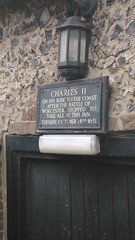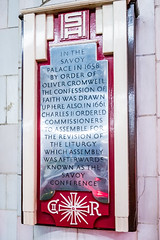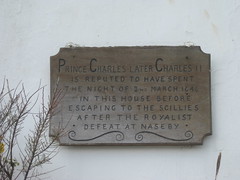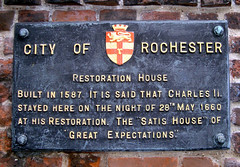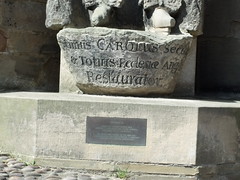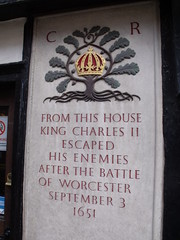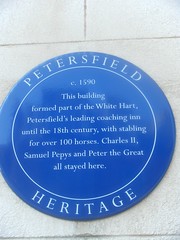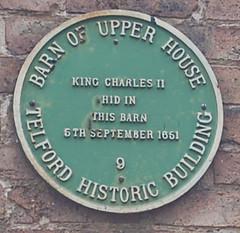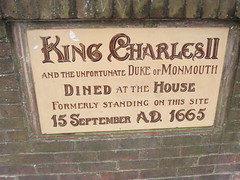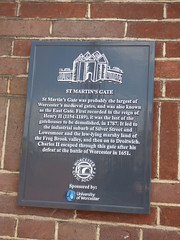King Charles II of England


King Charles II of England
(1630-1685)
King of Scots (1649-1651), King of Scots (1660-1685), and King of England (1660-1685)
Family tree
-
King Charles I of England (1600-1649) King of England
mother?
- King Charles II of England (1630-1685) Catherine of Braganza (1638-1705)
- Princess Henrietta of England (1644-1670) Princess of England
- King James II of England (1633-1701) King of England
- Sir Duke Henry Stuart KG (1640-1660) Duke of Gloucester
- Princess Elizabeth Stuart (1635-1650) Princess
- Princess Anne of England (1637-1640) Princess of England
- Mary , Princess Royal (1631-1660) Princess Royal
Commemorated on 16 plaques
This house was the residence of Captain John Trowts (Mayor 1660). Herein he entertained King Charles II, whose exile at Breda he shared
Court Street, Faversham, United Kingdom where they was entertained
Charles II on his ride to the coast after the Battle of Worcester, stopped to take ale at this inn. Tuesday, October 14th 1651
The George & Dragon, Houghton, United Kingdom where they stopped to take ale
In the Savoy Palace, in 1658 by order of Oliver Cromwell, the Confession of Faith was drawn up. Here also, in 1661, Charles II ordered commissioners to assemble for the revision of the liturgy, which assembly was afterwards known as the Savoy Conference
Savoy Court, London, United Kingdom where they ordered commissioners to assemble for the revision of the liturgy
Prince Charles - later Charles II is reputed to have spent the night of 2nd March 1646 in this house before escaping to the Scillies after the Royalist defeat at Naseby
The Square, Marazion, United Kingdom where they stayed
Warrington Bridge played an important part in the defence of the town by the Seventh Earl of Derby in 1643. The remnants of the Duke of Hamilton's army surrendered here to Cromwell after the fight at Red Bank, Winwick, in 1648. King Charles the Second accompanied by the Duke of Buckingham fought in a skirmish here in 1651. The Earl of Derby crossed the bridge in the same year on his way to execution at Bolton. The central arches were destroyed in 1745 to check the progress of the Young Pretender. This tablet was erected by the Warrington Society in 1927.
Warrington Bridge, Mersey Street, Warrington, United Kingdom where they fought in a skirmish
Restoration House Built in 1587, it is said that Charles II. stayed here on the night on 28th May 1660 at his Restoration. The "Satis House" of "Great Expectations".
Crow Lane, Rochester, United Kingdom where they stayed (1660)
Charles II After the ravages of Civil War, Charles II gave money and timber towards the repair of this cathedral. His statue was placed in the principal position on the west front where it remained until the 19th century restoration
Lichfield Cathedral - The Close (below the statue of Charles II), Lichfield, United Kingdom where they gave money and timber
From this house King Charles II escaped his enemies after the battle of Worcester September 3 1651
King Charles House, 30 New Street, Worcester, United Kingdom where they escaped (1651)
c. 1580 This building formed part of The White Hart, Petersfield's leading coaching inn until the 18th century, with stabling for over 100 horses. Charles II, Samuel Pepys and Peter the Great all stayed here.
Winton House, High Street, Petersfield, United Kingdom where they stayed
The Old George Inn. King Charles II came here September 23 1651.
Cancer Research UK, 9 East Street, Bridport, United Kingdom where they came here (1651)
Barn of Upper House, Church Street, Madeley. King Charles II hid in this barn, 5 September 1651.
King Charles Barns, Church Street, Madeley, United Kingdom where they hid (1650)
King Charles II and the unfortunate Duke of Monmouth dined at the house formerly standing on this site 15 September A.D. 1665
Sainsbury's Local, High Street, Poole, United Kingdom where they dined (1665)
Epsom High Street Three hundred years of history have left their mark on the high-street. 1618 The mineral well on Epsom Common is discovered to have medicinal qualities. 1672 Thomas Shadwell's play Epsom Wells is performed for Charles II. 1707 John Livingstone opens entertainment facilities at the New Wells off the High Street. 1724 Defoe’s Tour Through Britain comments:- ‘…the nobility and gentry go to Tunbridge, the merchants and rich citizens go to Epsom… the common people chiefly to Dulwich and Streatham’. 1779 The first Oaks horse race is run on the Downs, followed by the first Derby in 1780. 1833 Epsom market is established in the Highs Street. 1847 railway station opens in Upper High Street, followed by one on the presence of in 1859. 1937 A dual carriageway is completed in the eastern half of the High Street. 1990 The highway moved to the north side try provide a pedestrian Market Place once again. 1993 The new Market Place improvement scheme is completed.
High Street, Epsom, United Kingdom where they was
St Martin's Gate St Martin's Gate was probably the largest of Worcester's medieval gates, and was also known as the East Gate. First recorded in the reign of Henry II (1154-1189), it was the last of the gatehouses to be demolished, in 1787. It led to the industrial suburb of Silver Street and Lowesmoor and the low-lying marshy land of the Frog Brook valley, and then on to Droitwich. Charles II escaped through this gate aftr his defeat at the battle of Worcester in 1651.
Corn Market (near the end of New Street), Worcester, United Kingdom where they escaped (1651)
Pink Plaque Project #P
Nell Gwynn 1650-1687 Prolific celebrity actress of the Restoration period, one of the first on the English stage, and praised by Samuel Pepys as 'pretty witty Nell'. Best known as a mistress of Charles II, she had two sons by him. Charles (Created Earl of Burford and later Duke of St Albans) and James Beauclerk. She briefly lived at Lauderdale House
Lauderdale House, Highgate Hill, Highgate, London, United Kingdom where they was
City Wall - adjoining Salvation Army Citadel. The City Wall was 2⅛ miles in circumference when it was completed in 1534, almost 200 years after building began. This section was finished in the early 15th century and archaeological excavations on this site in 1960 revealed traces of a semi-circular bastion and a defensive ditch. In 1662, the wall was destroyed by order of Charles II, and now only fragments remain
Lamb Street, Coventry, United Kingdom where they was


